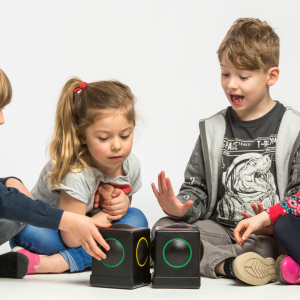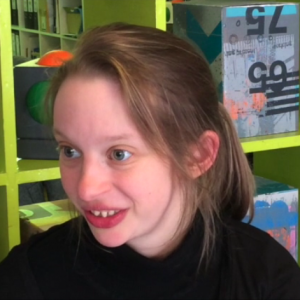‘Music can have lots of benefits from concentration to listening to therapeutic benefits…relaxation, working with musical instruments, good expression of how people are feeling or not feeling and, depending on the mood of the service users we work with, we tailor the music to meet their needs.’
(Cedarwood, 2010)
People with a learning disability are entitled, like all of us, to lead a full and rewarding life. They want to learn skills for communication, work, and leisure.
Cedarwood is a day service for adults with a learning disability. Their aim is to provide each individual with the opportunity to expand and enhance any existing skills and develop new skills enabling them to reach their full potential and maximize on their capabilities. And they are always looking at innovative and effective ways to develop such skills.
The team at Cedarwood carried out some research using Skoog with 20 of their clients.
Skoog is an easy-to-play musical instrument that can recreate the sounds of other instruments and can be tailored to the precise needs of the user. The Skoog can be touched, squeezed, shaken, thrown, rolled, dropped and hit to accurately control instruments, sound effects, and samples.
Sessions were organized into small group situations. Initially, the Skoog was used as a way for the service users to express themselves and to promote sharing and cooperation with others.
“I would often sing each group members’ name to a simple chord progression (hereafter referred to as The Name Song) to indicate whose turn it was before stepping back and allowing them to direct the musical expression.”
How music helped this adult to communicate:
“John has visual and auditory impairments and cannot verbalize. He has full physical mobility but does not respond directly to instruction. Initially, I noticed that John responded well to loud, upbeat music and often shook his head and clapped his hands in response. I also discovered that John was interested in touching musical instruments carefully and liked to explore objects before engaging with them.”
“John was involved in sharing the Skoog, mainly on the floor or from a chair at the side of the room. John would ‘get a feel’ for the Skoog by picking up the portable speaker to feel the vibrations while I touched a panel to trigger a sound. However, even after familiarising himself with the Skoog, John was cautious when playing and was shy to actively participate despite hearing a song or a piece of music.”
What happened next…
“After several weeks, I had noticed that John seemed to favor the drum sound and began to prompt him through ‘The Name Song,’ adding the lyrics: John plays the drums. John would then instantly press the top panel on the Skoog several times excitedly. For members of staff, this was a breakthrough and, in subsequent weeks, I was able to sing this song and John would immediately participate. At first, John would only play the drum sound but, through repetition, he could play a multitude of sounds along to the song. When I sang John’s name to a loud backing track, John played the Skoog while rocking back and forward rhythmically. Gradually, John became more involved and touched the Skoog with more confidence and enthusiasm. A great success.”
“If I were to work with John again, I would focus on his fondness of deep exploration and aim to reduce the sensitivity of the Skoog so that he was pressing it harder and touching it in different ways.”
The case studies demonstrate that the Skoog can benefit a range of service users with a variety of disabilities. It was also found that all the participants were able to use the Skoog regardless of how severe or complex their needs. John liked to feel the vibrations of the speaker which allowed the Skoog to become a vibrotactile communication system which, according to Özcan (2004: 326), can ‘…help people with impaired hearing to recognize the sound related to their surroundings.’
The ability to customize the Skoog to the needs of the user was vital to the success of this project
‘I think it’s been a fantastic tool in terms of working with service users, particularly service users who have very complex needs. For them to be able to touch something and get a response and then understand the response is absolutely incredible.’
How can I have a go?
- To get your very own Skoog 2.0, online or instore at Apple or online on Amazon.
- Get in touch with Skoogmusic here.

